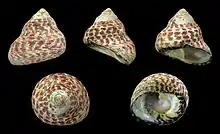Phorcus sauciatus
Phorcus sauciatus is a species of sea snail, a marine gastropod mollusk in the family Trochidae, the top snails.[1][2]
| Phorcus sauciatus | |
|---|---|
 | |
| A shell of Phorcus sauciatus | |
| Scientific classification | |
| Kingdom: | Animalia |
| Phylum: | Mollusca |
| Class: | Gastropoda |
| Subclass: | Vetigastropoda |
| Order: | Trochida |
| Superfamily: | Trochoidea |
| Family: | Trochidae |
| Genus: | Phorcus |
| Species: | P. sauciatus |
| Binomial name | |
| Phorcus sauciatus (Koch, 1845) | |
| Synonyms[1] | |
| |
Description
The size of the shell varies between 11 mm and 27 mm. The imperforate, rather thin shell has a low conical shape. The coloration is excessively mutable, as well as the general form. Its ground color is greenish, especially on the body whorl, usually purplish on the spire, and either:
- spirally encircled by bands of dark green, black, or red oblong spots articulated with a lighter color
- or obscurely mottled with reddish, the ground color covered with fine oblique or zigzag lines.
The pattern is sometimes so obscurely mottled, spirally and obliquely streaked, that it appears nearly uniform olivaceous, especially on the body whorl. The conic spire is more or less elevated. The minute apex is acute, reddish, when not eroded. The sutures are well impressed. The shell contains six whorls that are spirally more or less obviously, finely, irregularly striate or lirate. The body whorl is rounded or subcarinated at the periphery. The base of the shell is somewhat convex, more or less impressed around the axis, sometimes eroded in front of the aperture. The large aperture is very oblique. The outer lip contains a black-spotted green edge, which is generally followed by a broad thin opaque-white band, within which it is nacreous and iridescent. The oblique columella is thin-edged, the edge convex in the middle. The columellar area is white and more or less eroded. The umbilical tract is covered by a thick pad of enamel.[3]
Distribution
This species occurs in the following locations:[1]
- European waters (ERMS scope)
- Portuguese Exclusive Economic Zone (Madeira)
- Spanish Exclusive Economic Zone (Galicia, Canary Islands)
References
- Phorcus sauciatus (Koch, 1845). Retrieved through: World Register of Marine Species on 18 December 2018.
- Donald K.M., Preston J., Williams S.T., Reid D.R., Winter D., Alvarez R., Buge B., Hawkins S.J., Templado J. & Spencer H.G. 2012. Phylogenetic relationships elucidate colonization patterns in the intertidal grazers Osilinus Philippi, 1847 and Phorcus Risso, 1826 (Gastropoda: Trochidae) in the northeastern Atlantic Ocean and Mediterranean Sea. Molecular Phylogenetics and Evolution, 62(1): 35–45
- Tryon (1889), Manual of Conchology XI, Academy of Natural Sciences, Philadelphia (described as Monodonta sauciata)
- d'Orbigny A. D., 1839-1842: Mollusques, Echinodermes, Foraminifères et Polypiers recueillis aux Iles Canaries par MM. Webb et Berthelot et décrits par Alcide d'Orbigny. Mollusques; Béthune, Paris 117 p., pl. 1-7
- Pallary P., 1920: Exploration scientifique du Maroc organisée par la Société de Géographie de Paris et continuée par la Société des Sciences Naturelles du Maroc. Deuxième fascicule. Malacologie (1912) Larose, Rabat et Paris pp. 108, 1 pl., 1 map
- Donald K.M., Kennedy M. & Spencer H.G. (2005) The phylogeny and taxonomy of austral monodontine topshells (Mollusca: Gastropoda: Trochidae), inferred from DNA sequences. Molecular Phylogenetics and Evolution 37: 474-483
External links
- To World Register of Marine Species
- "Osilinus sauciatus". Gastropods.com. Retrieved 16 January 2019.
| Wikimedia Commons has media related to Phorcus sauciatus. |